#hair colorist san francisco
Text
Daredevil (vol. 1) #99: The Mark of Hawkeye!
Read Date: February 22, 2023
Cover Date: May 1973
● Writer: Steve Gerber ● Penciler: Sam Kweskin ● Inker: Syd Shores ● Colorist: Stan Goldberg ● Letterer: Artie Simek ● Editor: Roy Thomas ●

**HERE BE SPOILERS: Skip ahead to the fan art/podcast to avoid spoilers
Reactions As I Read:
● oo, crossover time! I'm excited!
● this is my first time reading Hawkeye in the comics and I am not impressed by him so far. I hope there's a reason for him acting like this--a reason other than 1970s male writer syndrome.
● at least Natasha is sticking up for herself… though sometimes her words don't align with her actions
● Natasha's hair isn't quite so big this issue. It looks better. The past several issues, I had "the bigger the hair, the closer to god!" in the back of my mind every time she came across the page
● Clint, STOP with the grabby-grabby
● oo, the shading of Black Widow's hair looks amazing in this panel:

● heh, I like how Daredevil finally subdues Hawkeye--by trapping him with his own bow
● he gets out of it pretty quickly though and fires an arrow at DD that wraps him up with some sort of rope
● Hawkeye is moping around San Francisco and bumps into a member of the "Hellbirds" biker gang
● he fights off the biker gang, then Daredevil shows up to try to talk to him. Hawkeye uses a sonic arrow, which of course totally incapacitates Daredevil because of his hypersenses
● the reader learns that the sonic arrow could actually kill DD, but its motor shuts off after a couple more seconds
● DD snaps Hawkeye's bow over his knee (he deserved it)
● DD and Hawkeye finally stop with their dick-swinging contest
● they go back to Natasha's house to find the Avengers waiting for them. The Avengers say they need help against Magneto
● Heh, Thor says it best (to Hawkeye): "…thine unprovoked hostility doth sorely try my patience!" That's how I've felt through this entire issue. And I was so excited for the crossover, too, dammit
● DD agrees to join the Avengers in battle this once; Hawkeye has stormed off to pout somewhere
● whines Do I wanna read Avengers #111 or just have one of the podcasts I listen to synopsize it for me? Yeah, I think I'll do that.
● 👏👏(saved from being a 1-clap by Black Panther, Natasha sticking up for herself, and DD emphasizing to Hawkeye that it is Natasha's decision)
Synopsis:
Returning home from their battle against the Dark Messiah, Daredevil and Black Widow are greeted by Hawkeye, who had just recently quit the Avengers, and has shown up in San Francisco to rekindle his romance with the Black Widow.
This doesn't go over very well with Daredevil, who tries to get involved in the conversation, which further agitates Hawkeye. It finally gets to the point where the two end up fighting it out. The brawl ends when Daredevil pretends to be "blinded" by Hawkeye's phosphorous arrow, at which point Hawkeye calls off the fight and leaves the scene. Daredevil then goes off to track down Hawkeye so that the two of them can "talk it out." He finds the avenging archer just as he has defeated some bikers and swoops in to talk to him but Hawkeye interprets this as if Daredevil has come to continue their fight. The two heroes duke it out again, fighting to a standstill at which point they then decide to stop fighting and let Natasha decide who she wants to be with.
Returning to Black Widow's home, they soon find that they're going to have to wait for Natasha's answer as the Avengers, Thor, Vision and Black Panther have arrived to recruit Daredevil to help them save members of the Avengers and the X-Men from Magneto. Hawkeye thinking the Black Widow called them to get him to leave storms out of the house. While Daredevil listens to their proposal. He initially declines but the Black Panther informs Daredevil that he owes him one due to previously assisting Daredevil in his time of need.[1] Daredevil accepts and so he, the Avengers, and the Black Widow depart in a Quinjet back to New York.
This story continues in Avengers Vol 1 111.
(https://marvel.fandom.com/wiki/Daredevil_Vol_1_99)

Fan Art: Daredevil found here
Accompanying Podcast:
● Josh and Jamie Do Daredevil - episode 14
#marvel#marvel comics#my marvel read#podcast recommendation#podcast - josh and jamie do daredevil#comics#comic books#daredevil#matt murdock#fan art#hawkeye#black widow#the crossover that dreams are made of#NOT the crossover that dreams are made of#why is hawkeye such a dick in this?
2 notes
·
View notes
Text
Unveiling the Beauty Haven: Exploring Luxury Hair Salon Los Angeles
An experience at a salon salon is more than regular grooming appointments It's an experience that makes you feel relaxed, confident, and prepared to take on the world. Salon services provide many different treatments and enhancements, delivered by highly skilled experts who are dedicated to enhancing the beauty of your skin.
In this post, we'll examine the wide range of Luxury Hair Salon Los Angeles services, and highlight the services that will assist you in achieving your ideal look and feel at your most beautiful.
Haircuts and Styling:
The mainstay of any hair salon is the ability to create haircuts and styles. You may be looking for an update to your style, or a complete overhaul with a fashionable haircut, stylists in a salon are skilled and have the imagination to bring your ideas to reality.
Hair Salon in Southern California take into consideration your hair style, facial shape and individual preferences to design a cut that enhances your appearance and complements your lifestyle.Alongside haircuts, salons also excel at styling that will change your appearance for any event.
Color Services:
Salons for hair are known for their ability to make hair color changes. If you're looking to enhance your highlights, hide the grays and alter your hair's color, the expert colorists at salons can assist you in achieving stunning results. They are knowledgeable of the theory behind color undertones, colors, and current fashions, allowing them to design custom shades that match your skin tone and your personal fashion.
From subtle balayage effects and the effects of ombre to vibrant fashion colors, or seamless root touch-ups colors offered in a hair salon provide unlimited possibilities.
Hair Treatments and Scalp Care:
Hair salons provide a range of treatments and services that enhance the condition and health of hair. From deep conditioning treatments that nourish your hair to smoothing treatments using keratin and massaging your scalp, the treatments are designed to rejuvenate and revitalize your hair.
Deep conditioning treatments offer an intense amount of hydration, and help restore damaged strands of hair that leave hair shiny, soft, and manageable. Massages on the scalp can also encourage relaxation and increase blood flow, which is beneficial for an overall healthy scalp and stimulating hair growth.
Extensions and Enhancements:
Salons that offer hair extensions also provide services for people looking to increase length and volume or temporary change in their hair. Extensions for hair are common option for those who are looking for lengthier locks or more thickness. Through various methods such as tape-in, clip-in or sew-in extensions stylists are able to seamlessly blend extensions with your hair, resulting in a natural and stunning result.
Professional Advice and Home Care:
Going to the salon salonisn't only about the services offered in salons but also receiving expert advice and suggestions regarding your routine for hair care at home. Colorists and stylists will assess your hair's type, state of health, and hair styling goals to offer you personalized recommendations regarding the appropriate products tools and methods to keep and maintain your hair after salon visits.
The Final Thought!
The Top Rated Hair Stylist in San Francisco use their knowledge as well as their creativity and enthusiasm to provide a unique experience that will leave you feeling and looking the most confident. So the next time you go to the salon, take the chance to take time for yourself and transformation. place your trust in these skilled professionals to let your hair's best potential be realized.
0 notes
Video
vimeo
FLIPPER'S SKATE HEIST | The Official Chronic Skate by Dr. Dre from Ben Dean on Vimeo.
If you had the chance to get your hands on something the world had never seen before… would you let the moment pass you by? Or would you risk it all and take what’s yours?
Writer/Director: Ben Dean
Executive Producers: Jason Cole, Danielle Hinde
Producers: Jeremy Sullivan, Joselo Hernandez, Campbell Von Beal, Laney Camenga
DP: Patrick Golan
Production Company: Doomsday Entertainment
Production Service Companies: THE LIFT (Mexico City), FRIEND (London)
Camera Operator: Connor O'Brien
Post:
Editing Company: Cabin Editorial
Editor: Sam Ostrove
Post Producers: Michelle Dorsch and Britt Carson
Color Company: Company3
Colorist: Tom Poole
VFX: Shape & Light
Sound Design and Mix: Raphael Ajuelos
Foley: Nathan Bonetto
OCP Cast:
Robber #1: Anastasia Lovera
Robber #2: Tyreece Boyce
Mexico Crew:
Producer (The Lift): Joselo Hernandez
Production Service Company: THE LIFT
Managing Director: Avelino Rodríguez
Managing Partner: José Barrera
MX EP: Pablo Chozas
Production Manager: Arturo Peña
Production Coordinator: Renata Hernández
1st AD: Paco Llaca
2nd AD: César Arjona
2nd 2nd AD: Belén Duarte
Script Supervisor: Karla Roldán
Storyboard: Rubén Nava Rodríguez
Camera Operator: Connor O'Brien
1st AC: Horacio Vega
2nd AC: Manuel García Hernández
Drone Op: Daniel Villagomez
Gaffer: Vladimir Martínez Gómez
Key Grip: José de Jesús Sotelo
Best Boy Electric: José Luis Calixto Valverde
BTS: Paul Billingsley
Production Designer: Emilia Dávila
Art Director: Maria Victoria Centurion
Set Decorator: Tomas Lecot
Art Coordinator: Tamara Puga
Art Assistant: Alejandro Pineda Hernandez
Construction: Arturo del Moral Angeles
SPFVX Glass: Jorge Cuitláhuac Farfan, Alfonso Benjamin Pacheco, Arturo San Vicente Curtidor, Omar Mauricio Duran Olvera
Skate Fixer: Emmanuel Addi Sánchez
Prop Master: Emanuel Buendía
Yanga Casting: Paola Gómez
Casting Director: Valentina Bouchot
Casting & Extras Coord.: Gil Rodríguez
Stunts Coordinator: Pablo Vinos
Stunts Assist.: Hugo Aguilera
Stunts: Esteban Muñoz, Gad Cruz
Riggers: Jason Rodriguez, Edueardo Blanco
Stylist: Lillian Dilustro
Wardrobe Stylist: Paola Alfaro
Wardrobe Coord.: Fernando Capurro Suárez
Wardrobe Assistants: Angel Susarrey, Yull Gonzalez
Hair Stylist: Carlos Arreola
Hair Stylist Assistant: Christian F. Alvarez
Make Up: Jorge Ramírez
Make up Assistant: Johan Vera
Pixel Digital Services: Jafet Gamboa Lopez
DIT: Luis Aldana Meza
VTR Operator: Juan M. Hernadez Mauri
VTR Assistant: Everson Negrete Valadez
Sound: Gerson Escudero
SFX: Alejandro Solin
SFX Assistants: Tomás Alejandro Castillo, Rodolfo Soto Guzman, Armando Castillo Álvarez
Picture Cars Coordinator Ernesto Mata
Picture Cars Assistants: Francisco Vallarino, Ivan Huerta
Precision Car: Ulises Guzmán
BG Cast:
Robber #3: Renee Costello
Robber #4: Rodrigo Paulo
Skaters: Alison Rocha, Samantha Coronel, Salvador Sandoval
Guards: Carlos Reyna, Leopoldo Dublic, Gearnys, Alan, Precious Emmarock, Jon Roberts, Fernando Daguerre, Jesus Osiris, Fernando Martín Del Campo, Daniel Veloz, Constantino Caso
Stunts: Gad Cruz, Esteban Muñoz, Adi
London Crew:
Production Service Company: FRIEND
EP: Chris Abitbol
Producer: Campbell Von Beaton
DP: David Procter
Production Manager: Natalie Uglow
Production Assistant: Alice Kommu
1st AD: Chris Malin
2nd AD: Lawrence Azoulay
Focus Puller: Sam Rawlings
2nd AC: Andy Jones
Grip: David Bradshaw
Video Playback: Charlie Gibson
DIT: Kier Garnett Lawson
Gaffer: Sol Saihati
Electrician: Christian Hayes
Rigger: Emily Hefferman
Art Director: Sofia Saccomani
Client:
Client / Agency: Interscope Records, Flipper’s
Label Producers: Jimmy Iovine, Liberty Ross, Jared Shelton, Andrew Ibea, Michelle An
0 notes
Text
Brazilian Keratin Hair Treatment
There are a wide range of hair treatments like coloring, highlighting, curling, relaxing offered in salons nowadays. Many even have used all of them or at least a few of them based on the requires. One popular part about all of these treatments is that they are chemical based. Chemical treatments even though might offer satisfactory outcomes, in the long run it is not great for the health of the hair. Submitting the hair usually to these therapies will damage the texture of the hair and may cause permanent harm. It is easy to understand that some services like coloring is unavoidable but there is always a option to go for chemical free treatments as far as possible.

Brazilian Keratin Hair treatment is one such innovative hair straightening strategy which is totally free from chemicals and primarily based on keratin. Keratin is a highly strong protein which is a main component in skin, hair, teeth and nails. It regenerates damaged hair and gives volume to the hair. Several people have vouched for better hair excellent after obtaining this treatment done. Brazilian hair straightening is ideal for all hair kinds and it performs best on chemical treated hair. It creates the hair soft and silky without resulting in any side-results or damage to the hair.
Brazilian keratin hair treatment is not a permanent straightening method. The effect will normally continue between 3-5 months and after this the hair will come back to its organic personal without destructive the hair in in any case. Following the treatment hair must be washed with unique sodium chloride free shampoo and conditioner particular to this keratin treatment.
Handling the hair after the keratin hair treatment is very simple and hassle-free. You simply require to blow-dry the hair and design it or basically leave it open. This is one treatment for all those who don't have time to manage their hair and make several visits to the beauty salon to design it. You will discover it so practical to handle your hair which will basically be more beautiful, healthy and full of volume. Brazilian hair straightening is a pleasant comfort from all the severe chemical treatments and your hair is confident to obtain its benefits.
#keratin treatment near me#brazilian keratin straightening#brazilian keratin treatment san francisco#brazilian keratin san rafael#balayage san francisco#brazilian keratin#keratin smoothing treatment san francisco#brazilian keratin treatment#hair colorist san francisco
1 note
·
View note
Text
Some Thoughts on Daredevil #600
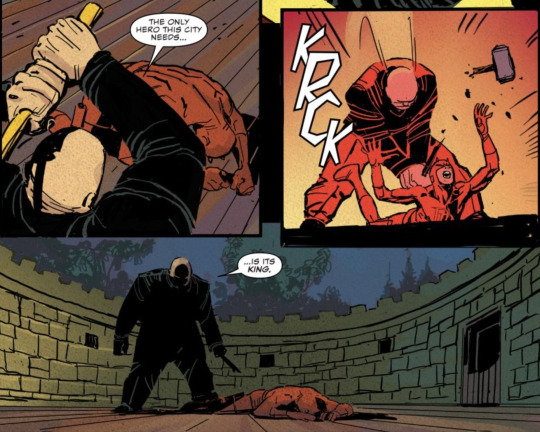
Here’s to 600 issues of Daredevil (not counting mini-series, annuals, etc.)! As usually happens at these landmark moments, Marvel and the DD creative team celebrated with a longer-than-normal issue, which sparked far-reaching changes to Matt Murdock’s world.
The situation set up by this story arc is a grim one. Wilson Fisk has been elected mayor of NYC. Matt has been keeping an eye on him (and vice versa) as Fisk’s deputy, but has struggled in his every attempt to sabotage him. However, he has recently discovered a crack in Fisk’s law-abiding facade: a meeting that he has planned with the city’s prominent street-level villains. Matt, as Daredevil, gathers together a gang of heroes to crash the party.

Matt: “We protect this city, we fight in its streets, we are New York. And now we’ll take it back from Wilson Fisk. Mayor or not, he has to go down. We agree on that.”
Colorist Matt Milla still hasn’t quite gotten the hair color memo, because poor Jessica has lost her brown hair. It also would have been nice to see Colleen in this team-up, since Misty is there. But these are minor complaints. In a series that restored Matt’s secret identity and thus symbolically isolated him from many of his friends, it’s a powerful gesture, in this climactic issue, to see him engaged in this kind of a team-up... even if most of the people involved still don’t know who he is. It’s especially nice to see Maya (Echo) here, back in action alongside her former friends. Since her resurrection early in the run she has had a few really touching moments of reconnecting with Matt, and we hope to see more of her as the series continues.
Matt has pulled off similar plans in the past, and he has taken down Wilson Fisk in some thoroughly delicious ways, but in this instance, it ends up not being that easy. And we like that-- Fisk has been one step ahead of Matt for this whole arc, and it would have felt anticlimactic for such a simple, faulty plan to bring that to an end. Rather than catching Fisk red-handed, the Kingpin doesn’t show. The collected villains turn on each other, the heroes swoop in to prevent any unnecessary deaths... and then the cops arrive.
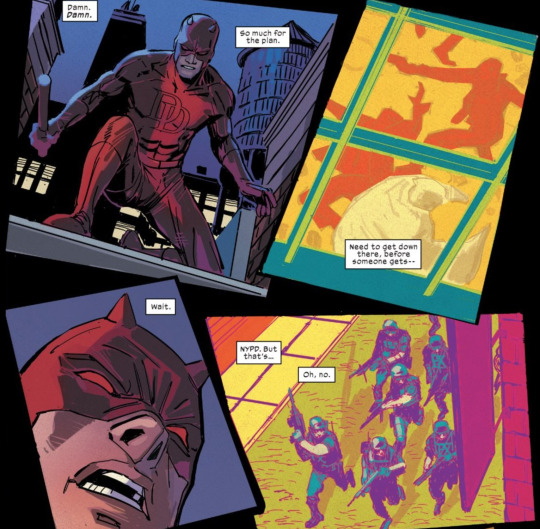
Matt: “Damn. Damn. So much for the plan. Need to get down there, before someone gets-- Wait. NYPD. But that’s... Oh, no.”
This scene, as exciting as it is, features a reappearance of the less-than-stellar Garney/Milla radar sense, which we’ve complained about before.
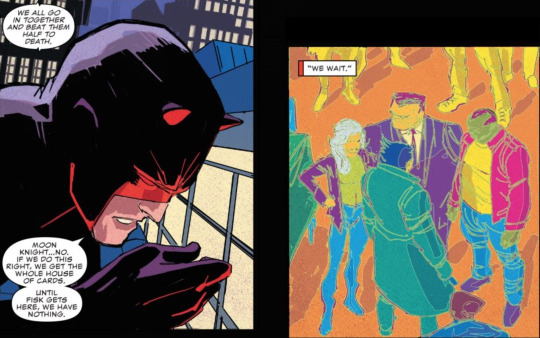
There has always been inconsistency, but generally, modern depictions of the radar sense don’t allow it to pierce solid objects. Here, we see Matt tracking the activity in the restaurant from outside, a blatant break with tradition that we’re not huge fans of. What makes even less sense is the arbitrary use of multiple colors. Since the radar depiction is a visual stand-in for non-visual perception, the different colors must represent something... but what? Texture? And in the panel where Matt notices the cops, his radar seems to be picking up on flat images and uniform details that he should have no way of perceiving. It’s a nonsensical, misleading approach to the radar sense, and a tragic departure from Paolo Rivera’s crosshatching design, which was used to great effect in volumes 3 and 4. We understand each creative team wanting to put their unique stamp on the comic, but come on... if it ain’t broke, don’t fix it.
The police swoop in and grab the heroes and villains alike. We learn-- in a neat twist that, again, fits with Fisk’s behavior in the issues leading up to this climax-- that the proposed meeting was a trap, designed to round up the city’s crime bosses and get them arrested. As Matt has done again and again in this arc, he assumed nefariousness on Fisk’s part, and ended up shooting himself in the foot. While we know that Fisk is still a bad guy, and probably has all sorts of things up his sleeve, it’s always fun to see him play the good guy, just to see how cleverly he constructs the facade. And even more compellingly, Matt’s failure to accurately read his nemesis backfires on his friends.
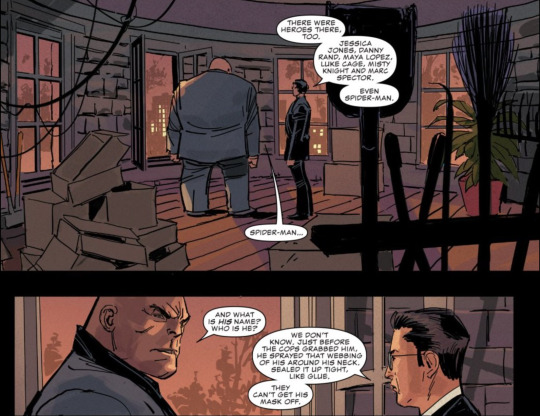
Wesley: “There were heroes there, too. Jessica Jones, Danny Rand, Maya Lopez, Luke Cage, Misty Knight and Marc Spector. Even Spider-Man.”
Fisk: “Spider-Man... and what is his name? Who is he?”
Wesley: “We don’t know. Just before the cops grabbed him, he sprayed that webbing of his around his neck. Sealed it up tight, like glue. They can’t get his mask off.”
(Oh, Peter. He’s so... experienced at this secret identity thing.)
It will be interesting to see how long they actually end up in jail, given the events of the rest of the issue. Hopefully, someone is babysitting Dani...
One of our favorite moments in this issue is a little reversal. While Matt has failed again and again to properly read his opponent, Fisk knows exactly how Daredevil works, and where to find him. It’s a level of familiarity between hero and arch-nemesis that is highly compelling to us. It’s these kinds of details that make for the best hero/villain relationships. It also gives Matt a chance to do a badass pose on Fisk’s roof, which is always a plus.
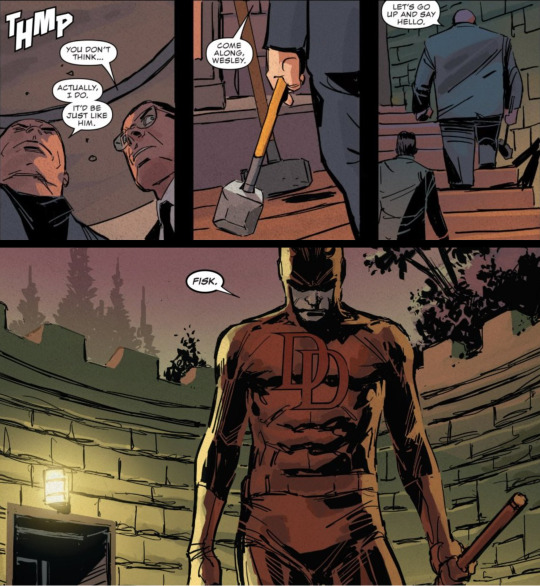
Fisk: “It’d be just like him. Come along, Wesley. Let’s go up and say hello.”
Matt: “Fisk.”
There have been so many iconic fights between these two over the years that it’s increasingly difficult to do anything new with them. This fight is certainly a good one... but then, they all are, and this tussle probably won’t go down in DD history as one of their memorable battles. But it’s still highly enjoyable, and is enhanced by Soule’s excellent dialogue, which highlights the core of their conflict, and emphasizes just how long they’ve been having these fights.

Fisk: “If my name weren’t Wilson Fisk, you wouldn’t have batted an eye. You’d be cheering that the mayor had found a way to get Owlsley and the others off the streets.”
Matt: “But you are Wilson Fisk. You are the Kingpin. And you’re the enemy of everything that matters about this city.”
Fisk: “No. I’m not. But I’m sick of trying to explain that to you.”
But as was foreshadowed throughout this arc, Matt isn’t allowed a clean win. Fisk hits him with a sledgehammer so hard that it’s amazing he’s able to stand afterward, and then goes off to tell a crowd of adoring supporters how great he is. Again, we are given a look at Fisk’s faked (probably?) duality, as Soule is exploring it-- the idea of him playing the hero while still being a villain. This isn’t a new Kingpin concept, of course, but it remains a good one, and an engaging way of playing with the character’s complexity.
Partway through the speech, the Hand arrive and shoot Fisk full of arrows, thus kickstarting the next story arc. The Hand are really neat when used well, so we’re excited to see where Soule takes them, particularly given their new connection to Blindspot. However, they are not this issue’s big surprise. We learn, as Matt is carted away by the cops, that with Fisk now out of the picture, the mayorship falls to his deputy...
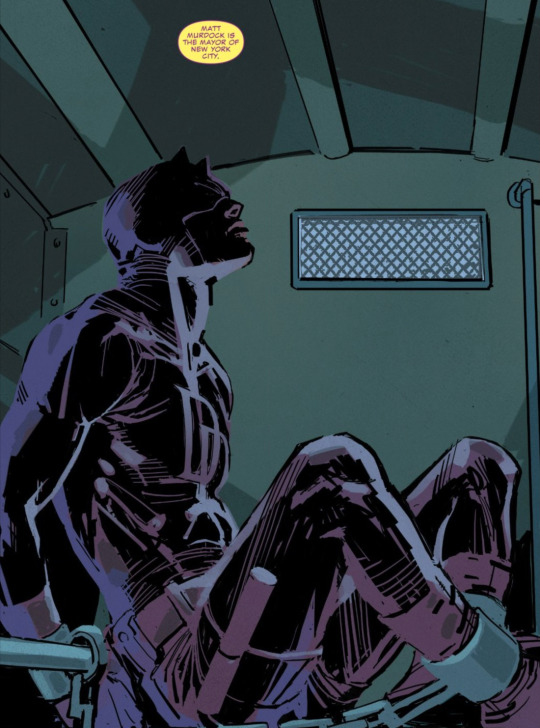
Steve: “Matt Murdock is the mayor of New York City.”
(Heck yeah!)
This is really exciting, not only because of its implications for Matt’s life, but also because it has been a long time coming. Kesel wanted to do it back in the 90s, but the idea was shot down by editorial. Bendis teased the possibility, but it never actually happened, thanks to the events of the rest of his run.

Guy: “They’re going to ask you to be the Democratic nominee for Mayor of New York City.”
Matt: “Huh.”
Daredevil vol. 2 #56 by Brian Michael Bendis and Alex Maleev
And Waid’s speculative story in the 50th anniversary issue suggested that Matt had been/will become the mayor of San Francisco at some point, but we don’t get to actually see him in action.
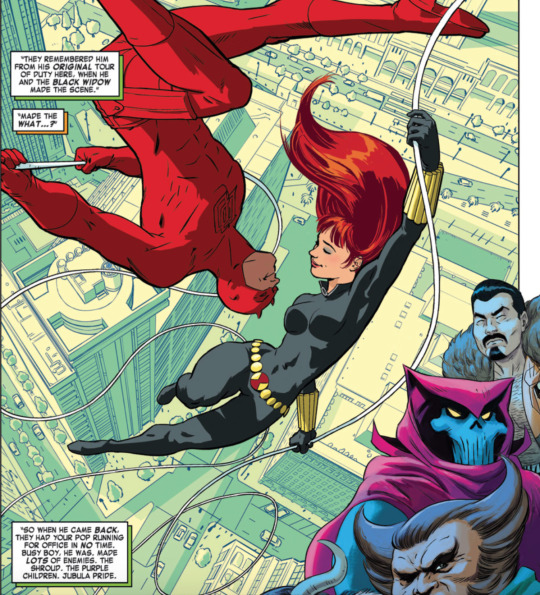
Foggy: “They remembered him from his original tour of duty here, when he and the Black Widow made the scene. [...] So when he came back, they had your pop running for office in no time. Busy boy, he was. Made lots of enemies.”
Daredevil vol. 4 #1.5, “The King in Red” by Mark Waid and Javier Rodriguez
But we are finally getting Mayor Matt Murdock, and we cannot wait to see how that works out for him.
The issue’s secondary plot thread is possibly even more interesting than the Matt/Fisk shenanigans, because it’s all new. This thread follows Sam’s final battle with Muse... who is essentially a Blindspot rogue now, rather than a DD one. Their relationship is fascinating, with Sam’s quest to understand the nature of his own heroism/lack thereof paired with Muse’s frenetic lack of morality. They are both raw, emotional characters, and their interactions in this issue are stunning. We’re gonna miss Muse.

Sam: “I need to understand, Muse. I need this to make sense. Why do you do what you do? Why do you hurt people? Why do you kill? Why?”
Muse: “You know why, Blindspot. It’s the same reason you want to kill me right now. It makes you better it makes you strong it shows them your power it says something it means something it solves your problems it gives you control you’re big they’re small it’s art it’s art IT’S ART!”
This fight also hints that Sam’s connection with the Hand is far from over... and provides a glimpse at how his time training with them may have changed him.
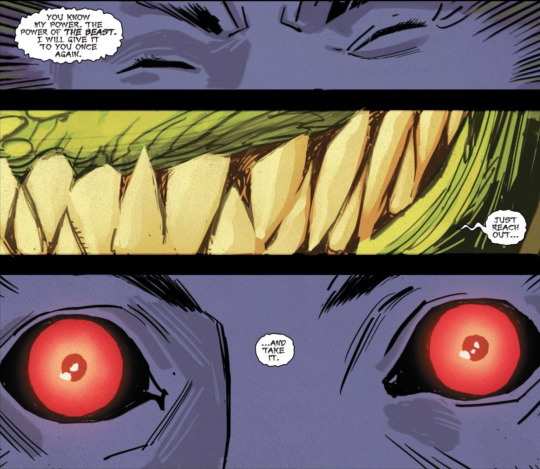
Beast: “You know my power. The power of the Beast. I will give it to you once again. Just reach out... and take it.”
While Sam refuses to kill for the Beast, this relationship will likely continue into the next arc-- which appears to be Hand-centric. Sam’s continuing evolution has been full of surprises, and we’re eager to see where this story takes him. All-in-all, this issue didn’t stand out as one of the most earth-shattering Daredevil stories ever told, but it was still thoroughly enjoyable, and did a great job of setting up some very exciting things in the future.
As an extra treat, the issue also includes a short, Foggy-centric story called “They Also Serve” by Christos Gage, Mike Perkins, and Andy Troy. This is merely the latest in a long line of Foggy-centric stories that celebrate his relationship with Matt. And there’s not a dang thing wrong with that, because they never get old. Matt and Foggy’s friendship exists at the very core of the comic, and its power and poignancy only increases as the years go by. Give us all of the Foggy-centric retrospectives. We will get misty-eyed every time.
We have only one complaint about this story, which is that Foggy... doesn’t really sound like Foggy for parts of it.

Foggy: “This is gonna be so great! You have no idea how lucky you are, Murdock, ‘cause Foggy Nelson just happens to be the finest wingman in the history of wingmen. You just stand there looking handsome, strong, stoic... with a hint of tragedy, while I draw ‘em in with my oratorical virtuosity. Between my silver tongue, your looks, and the whole blind thing, you’re gonna need that cane to ward off the babes.”
(Who... who are you, and what did you do with the real Foggy?!)
In fact, he sounds just like MCU Foggy. Which maybe shouldn’t have surprised us, because Christos Gage was also a writer for the first season of the Netflix show.
Despite this bit of weirdness, the issue is a nice look back at moments in Matt and Foggy’s friendship. It’s a trip down continuity lane, emphasizing just how long they’ve known each other and how much they’ve been through together.
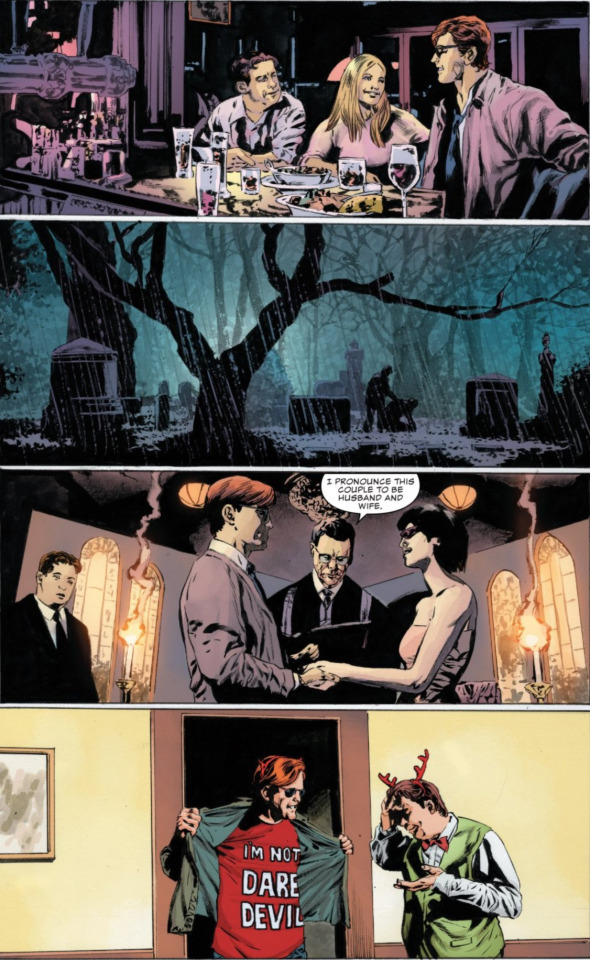
All told, it’s a pleasant way to close out the issue, particularly given the rocky state of Matt and Foggy’s friendship throughout this run.
82 notes
·
View notes
Photo

CYCLONE NOW PLAYING THRU 1/10 • OFFICIAL SELECTION SAN FRANCISCO LATINO FILM FESTIVAL • LINK IN BIO FOR TIXS • CYCLONE directed by Austin Tsung-Fu Chang, screenplay by Francisco Solorzano; co-produced w/ Creative Class 6 starring Natalia Baron, Francisco Solorzano and the Barefoot Theatre Co. Representation matters! • CREATIVE TEAM: Carrie Stalk (Cinematographer), Lisa Burrascano (Assistant Director), Sam Weiner (Sound), Bianca Puorto (Production Designer / Associate Producer), Joanne Solorzano-Dorfman (Hair & Make-Up), Nikki Jackson (Costume Designer), Judi Ockler (Intimacy Coordinator), Renee Goust (Orignal Score), Ellie Gravitte & Kenny Neal Shults (Editors), Miguel Herrera & David Jeremiah Rodriguez (BTS Photographers), Sydny (Line-Producer), Connected Health Solutions (Associate Producer), Mateo Marquez (Colorist), Farrah Dupoux (Sound Design) and featuring music by Cazike (Victor Almanzar)! • • • #CycloneFilm #IndieFilms #shortfilm #MakingMovies #films #ConeyIsland #SagAftra #actors #acting #nyc #latinos #latinx #barefootstudiopictures #barefoottheatreco #creativeclass6 #drama #familia #grateful #finalist #womeninfilm #screenplay #femalefilmmakers #filmfestivals #awardwinner #awardwinningscreenplay #filmfestival #festival #off2020 (at Cine+Mas SF / San Francisco Latino Film Festival) https://www.instagram.com/p/CJ0CxddjOvo/?igshid=1l6c6yn2ys7a9
#cyclonefilm#indiefilms#shortfilm#makingmovies#films#coneyisland#sagaftra#actors#acting#nyc#latinos#latinx#barefootstudiopictures#barefoottheatreco#creativeclass6#drama#familia#grateful#finalist#womeninfilm#screenplay#femalefilmmakers#filmfestivals#awardwinner#awardwinningscreenplay#filmfestival#festival#off2020
0 notes
Text
Studio Colorist
New Job has been published on https://salonhelpwanted.com/job/esalon-san-francisco-ca-usa-studio-colorist/
Studio Colorist

Do you have a passion for hair color, a desire to grow your craft, and truly enjoy helping clients look and feel their best? Then eSalon is looking for you to join our fast growing team! We are seeking new grads. and seasoned professionals to become an eSalon Colorist.
This is not a traditional salon job. eSalon offers the best of both worlds; a creative outlet to help clients achieve their hair color goals and the stability of a full-time / 40 hour per week schedule with benefits, paid time off, paid holidays, and 401K.
You’ll be using your coloring knowledge and excellent customer service skills on a daily basis to formulate, apply color and highlights, and educate clients on all of the benefits of eSalon in studio and at home.
What You’ll Be Doing:
Provide clients with consultations, custom color formulations, highlights, and applications in our Color Studio
Educate clients on how to apply color themselves at home
Encourage repeat orders and / or rebooking
Proactively build effective working relationships with clients and colleagues to ensure best customer outcome
Demonstrate critical thinking by fully analyzing clients’ objectives and concerns and providing appropriate solutions
Be a team player with an entrepreneurial spirit
Show openness to new ideas; listen to others and objectively consider other ideas and opinions
Collaborate with other departments and seek further advice and guidance when required
Other duties as assigned
All employees are eligible for sick leave, healthcare, and competitive compensation.
Full-time employees are also eligible for: 401K Plan; Add’l Paid Time Off and Paid Holidays; Employee Assistance Program; Rideshare program; Corporate Discount Program; Complimentary salon services
Requirements:
A current California Cosmetology License
In depth understanding of color formulation and theory
Positive attitude and polished appearance
Aptitude for selling and cross-selling
Excellent communication skills
Highly motivated, flexible, & energetic
Ability to follow directions
Ability to uphold eSalon values and be a strong ambassador for the eSalon brand
Benefits:
All employees are eligible for sick leave, healthcare, and competitive compensation.
Full-time employees are also eligible for: 401K Plan; Add’l Paid Time Off and Paid Holidays; Employee Assistance Program; Rideshare program; Corporate Discount Program; Complimentary salon services
Find more salon jobs at https://salonhelpwanted.com #salon #hair #job #nowhiring #love #hiring #salonhelpwanted
0 notes
Photo
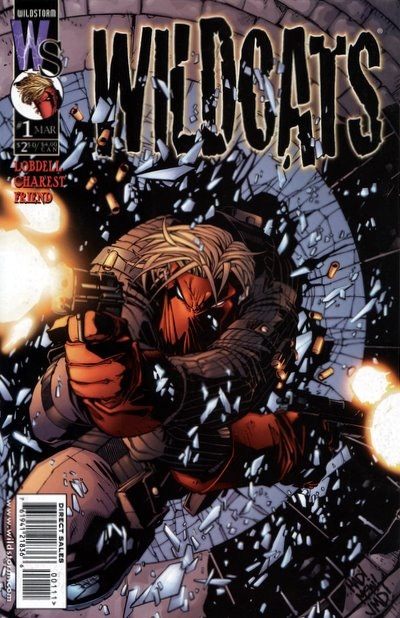
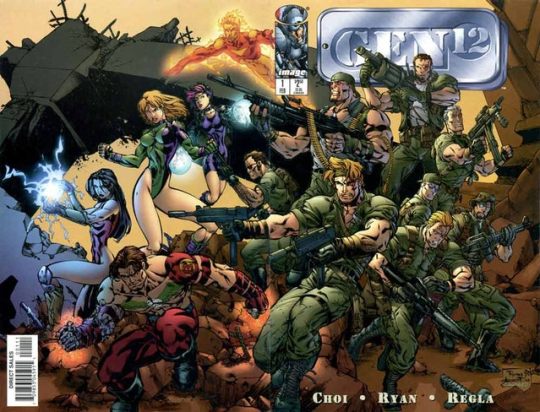
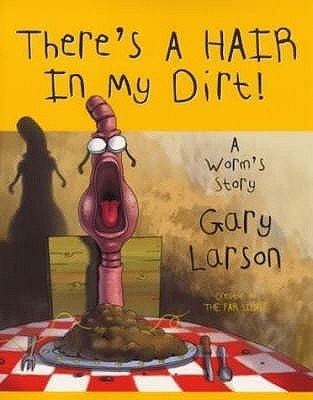
Director’s Cut Material #7- In Living Color
The following Director's Cut material is a very special one that I hope you all enjoy. Colorist Joseph M. Damon was kind enough to share his unique WildStorm journey that really shows what it was like to try and become a part of the WS group and see a dream realized. If you've been to some comic conventions, you might have seen him around as he usually assists Humberto Ramos out on the road.
Joseph and I connected after the manuscript was finalized so I was able to sneak in a couple of his quotes in the proper book but the more I tried to edit, the less I wanted to break up his story throughout the different chapters. So here it all is as one piece and my sincere thanks to Mr. Damon for sharing it.
Joseph M. Damon (Colorist): Outside of being the fanboy buying comic books at my local comic store in the Bay Area, I'd attend local comic shows, in particular Wonder Con (in Oakland at that time), SDCC and there was an Image convention in LA. This was circa 1993-1994. At the shows, WildStorm Fine Arts was a booth selling ashcans, color guides from Joe Chiodo, Iris prints, and original artwork. At that time [it] was run by Joe Mendoza (Whilce Portacio's brother in-law and [the] character Dozer was based on him in Wetworks), who was working as editor at Homage studios as well. I asked a ton of questions about color guides and the process behind them, what an iris print was (I purchased one of Travis' Burnout), drooled buckets over the original artwork from the books that were for sale as well (which of course led later to me buying original art). Joe gave me a smile and his card, which I still have, and I asked him about some of the artists. He gave me a second extension which was for the "The Pit" where at that time a lot of the new artists like J. Scott Campbell and Travis Charest sat. I stared at the card and within a week called in just to see what would happen. I got reception, asked for Joe and he's out of the office, asked to be transferred to the extension for the Pit. Not thinking I'd get anywhere, it rang and rang and then I heard a voice say "Pit", I asked to talk to Jeff Campbell, and they said hold on, and then I heard, "This is Jeff" and I just start telling him that I'm a big fan of Gen 13 and his work on The Art of Homage Studios book and hoped to meet him at a show and get his autograph and show him some of my work. Jeff said good luck and then before hanging up, I figure I'd gone this far, why not see where else I can take this... and asked for Travis Charest. Jeff said sure hold on and then passed the phone to Travis, we talked real briefly and hung up and I just sat in awe for a few minutes... and that was the moment where, sacking up and being assertive just made me feel ten feet tall talking to people whose names I saw in my favorite comics.
Now I just needed to put in the work and find a way to work there. Around the same time I met colorist Brian Haberlin, talked with him on process and tools/applications used by the studio. I found out the best way to practice working on color guides to be like Joe Chiodo was to make larger copies of ashcan pages and color them. So I mimicked a lot of what I saw in Joe Chiodo's work with multiple light sources and shading, light direction. I had a good portion of guides from Gen 13 mini-series #1, WildC.A.T.S. #5 and thought I was ready, so I found out at that time Bill Kaplan was in charge of submissions. I met him at a show, told him my name and showed my samples and my work was critiqued and it was ripped apart. Bad approach, terrible color theory, bad lighting. I listened and then commented on referencing Joe Chiodo's work, and he just looked at me and said thanks for letting me see your work and keep trying. Shortly after I met Steve Oliff and some of his guys from IHOC (International House of Color which would soon form Olyoptics), showed my stuff and also looked at his stuff from Akira and early Image color guides. He was really supportive, told me what media to use if coloring by hand and looking to Photoshop as digital was where it was at. I had an Amiga 500 and used color applications like digipaint, so Jumping to a Mac with Photoshop 3.0 was the next step.
I actually tried out for WildStorm back in early '90s when the studio had a talent search. Really didn’t have too much experience, but enough to get a call to show up and take the test. Met early WildStorm FX members, took the test given by Alex Sinclair and noodled the hell out of it and didn’t even finish in the allotted time, so [I] didn’t get the job. Come years later, I became good friends with several WildStorm FX members, Ian Hannin, James Rochelle, Jeremy Cox, Laura Martin (Depuy then) and Ben Dimagmaliw and heard about Andy Hartnell’s coloring spot opening up since he was writing Danger Girl. Send in samples, get a call to come take the test, fly down from San Francisco to San Diego, take the test, don’t finish due to catching a flight back home but get the file saved to a zip disk. Come home finish the test, send the file back in the morning, and then get the call that if I want the position its mine. I was currently testing video games at SEGA of America. [I] gave notice and started at WildStorm after relocating to San Diego a month later.
Day 1 at WildStorm, [I] get seated in the open area in “The Pit” facing Jim Lee’s office and to my left was Travis Charest & Tom McWeeney’s office… no pressure…breath right. Absolutely not, since my friend Ben Dimagmaliw had the Wizard magazine black and white picture of Jim Lee from the Top Ten and pinned it to the board in front of my desk…so now I had Jim staring at me. I kept it there to motivate [me] even when Jim would walk by and I was totally in awe…which I finally lost the fanboy-ness after four months. I still talked to Jeff Campbell, Scott Williams, Travis Charest and Rich Friend when they weren’t working to at least break the ice. Alex Sinclair and Nick Bell took me under their wings and showed me the essentials but soon after I got a lot of real tools to use as a colorist from my fellow colorists. I'd go in early to talk/watch day shift (Joel Benjamin, Tony Washington,etc) and at night talk with Justin Ponsor, Matt Millia, Eric Guerrero, etc., learning which artists like cut & grad or who liked airbrush, which books needed lots of color holds and knock outs and which books had none. Slow at first but was ramped up and rendering within a month and by the time I left, rendering two [pages] per day. But still, [I] was slow by comparison to others who could do three pages per day.
I was a huge fan of WildStorm's books as I picked [up] all the titles as they came out- from Wetworks, StormWatch, Gen 13 to WildC.A.T.S. WildStorm had the formula to take my money every month they came out with new books. From the first day I started, learning to flat books was the greatest thing ever. But that was the immediate glamour of working for Jim Lee. The first time I got to render a Gen 13 or Divine Right page was pretty cool, but while cool, you had a lot to do in a little time, so you turned into a machine to meet deadlines. Certain key items that I got to work on that stood out were Gary Larson’s “There’s a Hair in My Dirt”, coloring and art directing a ton of trading cards with David Baron, art directing Gen 12 issues with Eric Garcia and coloring Joe Madureira’s Wildcats #1 Grifter Variant was a highlight as I was not only a huge Grifter fan, but a fan of Joe’s work.
WildStorm FX had a lot of artwork to get done each day. Comic Books, trading Cards, specialty items like posters, DVD inserts, Gamepro or PSM magazine covers, Flash animated teasers for upcoming new release launches like Travis Charest’s Wildcats volume 2, strategy guide walkthroughs, etc. We did a lot and it did change day to day. Sometimes you knew you were flatting four pages and rendering two pages. Sometimes you colored four trading cards.
I was hired on for the nightshift and worked four to midnight or later to meet deadlines. So my hours were interesting to say the least. At the end of my first year at the studio, my son, Niko was born, so challenges of a newborn, and being alone in San Diego got to be very tough for my then wife, so she went back to the bay area to be with family. Even with weekend trips back to see my family, shortly after my year mark, I made arrangements to return back to the bay area and return to my family and work in the video game industry. So I of course placed my two weeks notice and left the studio but continued to freelance for off and on for a bit and continued to freelance for Image comics.
What made WildStorm amazing was the people. The whole family worked together to get work done each day. Every person in WildStorm had a key role and made that place great. So while you think you have Jim Lee in drawing WildC.A.T.S, Scott Williams inking a page, Alex Sinclair coloring another, you have the rest of the studio doing their daily tasks… and a studio filled with laughter, music, discussions of who the Chargers or Padres played the night before, what movie flopped, or what new appetizer was on the menu at Moon Doggies Grill…this was day in/day out WildStorm. What Jim had set up was incredible to work for and some of that disappeared when DC took over. The initial announcement to us was a full company outing, where we were all told of the sale of the company to DC and what was changing and what would stay the same. Initially for me, there was some heartbreak, simply for what the mission statement of Image Comics was and why the founding fathers did what they did. WildStorm was a huge part of why Image was so big in the '90s and now it was gone to an extent since Time Warner was now the boss, a conglomerate, where before it was one man, figuratively speaking.
DC seemed very cool to work for. All hourly employees got a raise based on cost of living at that time, which was good, as it got me closer to what I was making prior in the bay area. Another benefit was employees now received comp copies every week of every DC item that shipped, be it a TPB, Hardcover, comics and sometimes toys/statues. Which when you’re 25 and a comic collector, is great. But for me it was close to the end.
The experience was, best said, as a once in a lifetime, when it came to being listed amongst the best of the best in Artists/Inkers/Writers/Colorists. Few are able to say that. Even with very tight deadlines, (Fedex daily by 5PM), and long hours to make sure that the next shift had all the work ready for them, working along side the best was just that, the best. Aside from taking the knowledge of tips and tricks that WildStorm taught you as part of WildStorm FX, the friendships that I still have with my co-workers. Some are that of a hey, or head nod, while others are huge hugs annually at various comic cons, or random chats and discussions on Facebook or on the phone.
The biggest take-away I can comment on is hard work/work ethics, and keeping your name fresh and in the public eye every month- in Previews, in at least one book, a variant cover, an interview, whatever. Those that stay relevant are those that continue to work every month delivering content. If you step out or take a break from the industry, it takes you five times the amount of work to get back to where you were, as there are pencillers, inkers, and digital colorists ready to take your spot, for cheaper rates. I still moonlight in the comic industry as a Manager/Handler but that’s simply because I'm still a huge fan of comics and those that create them.
2 notes
·
View notes
Text
Daredevil (vol. 1) #102: Stilt-Man Stalks the City!
Read Date: March 15, 2023
Cover Date: August 1973
● Writer: Chris Claremont ● Penciler: Syd Shores ● Inker: Frank Giacoia ● Colorist: {uncredited} ● Letterer: Artie Simek ● Editor: Roy Thomas ●
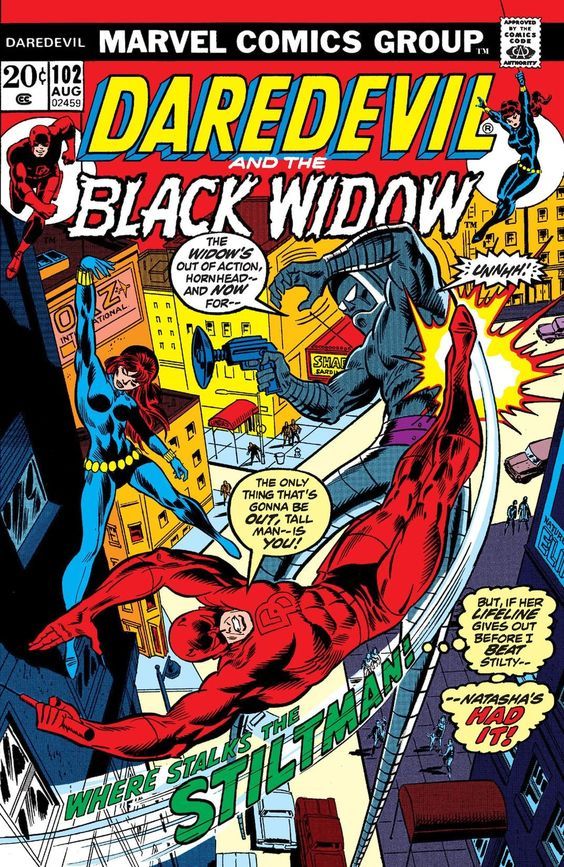
**HERE BE SPOILERS: Skip ahead to the fan art/podcast to avoid spoilers
Reactions As I Read:
● I’m not sure why Stilt-Man is so beloved, but his charms work on me, too. yay, Stilt-Man issue!!
● Tasha’s hair looks halfway normal in this issue
● Stilt-Man lookin’ good!

● so if Wilbur Day shrinks San Francisco, it’ll trigger the Andreas Fault and take half of California with it
● Natasha Alianovna? is that her middle name, or did the writers forget “Romanoff”?
● I’ve seen it “Stilt Man” and “Stiltman” in this single issue alone, but “Stilt-Man” on the Marvel wiki page, so I’ll keep with the hyphen for now
● 👏👏👏
Synopsis:
On the hunt to find Angar the Screamer, Daredevil scours all over San Francisco and finds no trace of the villain. He does however, detect a familiar heart-beat and goes to investigate it. Arriving at a warehouse he overhears an smuggling deal of special equipment being conducted by his old foe Wilbur Day, aka Stilt-Man. Breaking up the deal, Daredevil catches everyone except for Stilt-Man who escapes. Taking the equipment back to the home he shares with the Black Widow, the two heroes and try to figure out what sort of device he was looking to smuggle.
Stilt-Man meanwhile returns to his hideout where he and his thug Endros have William Kaxton, the man who created the Stilt-Man technology, and his daughter Barbara as his prisoner. He has been blackmailing Kaxton to work for him to create a molecular condenser in order to insure the safety of his daughter. Day is plotting to threaten to use the condenser to extort the city of San Francisco out of a billion dollars, but intends to destroy the city anyway after he has dealt final revenge against Daredevil.
Daredevil and Black Widow meanwhile have decided to look up Day's former employer deducing that he might have some key in defeating Stilt-Man. Checking the public library's newspaper records they learn of Kaxton's kidnapping and begin to search around the city for him. The two decide to split up, Daredevil searching for Klaxton since he knows the mans heart-beat and Black Widow out to keep an eye out for Stilt-Man.
Daredevil scours the city until he picks up Kaxton's heartbeat and tracks it down to Day's hide out. Easily taking out Stilt-Man's hired thug, he learns that Wilbur has left already, taking Barbara as a hostage, to use the completed molecular condenser on the Golden Gate Bridge as a show of power to the authorities of San Francisco. Daredevil rushes off to confront his old foe just as the Black Widow catches up with the crook.
Natasha manages to free Barbara and continue her attack on Stilt-Man knocking the condenser out of his hand and she manages to maintain an upper hand until he gets a shot in. Arriving just in time to save Natasha from a deadly fall, Daredevil angrily topples Stilt-Man down through a plate-glass window. With Stilt-Man defeated, Black Widow and Daredevil take Barbara back to her daughter. As for the molecular condenser, it is found by a homeless man who thinks he can make a quick buck from it, but when the bum thinks it's just a toy he throws it in the trash.
(https://marvel.fandom.com/wiki/Daredevil_Vol_1_102)

Fan Art: Daredevil Annual #5 Reimagining (John Byrne) by xts33
Accompanying Podcast:
● Josh and Jamie Do Daredevil - episode 16
#marvel#comics#daredevil#daredevil (matt murdock)#podcast - joshua and jamie do daredevil#stilt-man (wilbur day)#black widow (natasha romanoff)#fanart#comic books#fan art#podcast recommendation#marvel comics
1 note
·
View note
Text
Transforming Your Look: The Expertise of a Professional Hair Colorist in San Francisco
In order to get your ideal color, hair texture and style you can't beat the talent and expertise of an experienced hair colorist and stylist. In the thriving San Francisco city San Francisco, where fashion-forward trends and individuality are the norm choosing the best stylist to cater to the specific needs of your hair is crucial.
This blog will dive into the Professional Hair Colorist San Francisco and discover how they can transform your locks. We'll also introduce the extravagant Ibiza Hair Brushes that will assist you in maintaining your salon-worthy hair at home.
Role of a Professional Hair Colorist:
San Francisco is home to a vibrant community of hair colorists with professional experience who specialize in custom hair color changes. The experts have gone through an extensive course of study and honed their abilities over many decades of experience.
They know that getting the perfect hair color isn't just about choosing the right shade from a chart, it's about taking into consideration your complexion, lifestyle, and what you want to achieve.
Your Hair's Best Friend: Ibiza Hair Brushes
Maintaining the incredible results produced by your expert hair colorist is a matter of having the right equipment. You can count on Ibiza Hair Brushes, a known brand in the field of hair care. They are adored by both stylists and customers for their superior design and quality.
Made from boar bristles that are natural and heat-resistant material, Ibiza hair Brushes are ideal for all hair types and provide an easy and efficient method to smooth, detangle and style your locks. If you purchase the brushes, you're not simply buying a tool for styling it's making a commitment to the overall health and aesthetics that your hair has.
The Expertise of a Professional Hair Stylist:
While the colorist nips in your hair's color and style, the professional hair stylists located in San Francisco adds the finishing finish to your overall appearance.
The Professional Hair Stylist they employ are skilled at creating a range of hairstyles, from sophisticated and elegant to casually chic. They recognize the importance of having a perfect haircut to complement your hair's color and facial features, making sure that you leave the salon feeling and looking at your best.
0 notes
Video
vimeo
A bittersweet comedy about Steven, a recently divorced father and his young daughter, Cali. Steve’s perfect day with his daughter in San Francisco's Golden Gate Park is ruined when Cali’s mom comes to pick her up, leading Steve on an unexpected journey through the park. A Little Moving Pictures Production Of a film by 26 Aries (Irene Chin & Kurt Vincent) Written by: Adam Callahan Story By: Adam Callahan, Irene Chin, Kurt Vincent Produced by: Jeremy Summer Consulting Producer/Story Editor: Tricia Cramer Cast (in order of appearance): Steve: Steve Talley Cali: California Summer Dog: Beatrix Summerkirk Park Kid #1: Evan Walker Park Kid #2: William Walker Gabby: Alyssa Kompelien Park: Mom Melissa Chin Burger King Guy: Adam Callahan Stoner Chick: Irene Chin Stoner Dude: Alex Rapine And all the freaky people at 4/20/18 at Golden Gate Park Crew Irene Chin: Director Kurt Vincent: Director Jeremy Summer: Producer Tyler McPherron: Director of Photography Alex Rapine: 1st AD Jonathan Salazar: 1st AC Martin Bustamante: 2nd AC Ashley Valenzuela: 2nd AC Lemia Bodden: Coordinator Arthur Aravena: Gaffer Gaerick Duffin: Swing Ally Grace Esparza: Art Director Sam Hoiland: Art Assist Anya Zebroski: Wardrobe Stylist Alicia Barry: Hair & Makeup Artist Dalton Patterson: Sound Recordist Diana Rothery: Production Stills Additional Cinematography by Noe Chavez Music by Anthony Ferraro Editor: Nathan Petty Assistant Editor: Caleb Stumpfl Colorist: Chris Martin of Mission Film & Design Sound Mixer: Joel Raabe Titles Designer: Patrick Sean Gibson “Running In and Out” Performed By Dwayne Ellis Licensed from Marmoset Music “Children of the Beehive” written by Sonny Smith Performed by Sonny & The Sunsets Licensed from Bankrobber music Special Thanks Mission Film & Design Tommy Herbst Andrew Combra Dean Snodgrass Elise Polglaze Lindsey Kirk Mike Walker Melissa Chin Alan Steinheimer Morgan Henderson Ron E. Sweat Dedicated to: The park rangers who busted us but let us keep filming.
0 notes
Text
Some Ideas on Straightening Your Hair
The hot trend in hairstyles for the past numerous years is straightening out wavy or curly hair. The exercise of hair straightening is honestly common, but in certain cases the hair can be damaged or worse if the procedure is not done properly. Here are a few tips to assistance you straighten your hair and avoid some of the pitfalls that strength occur.
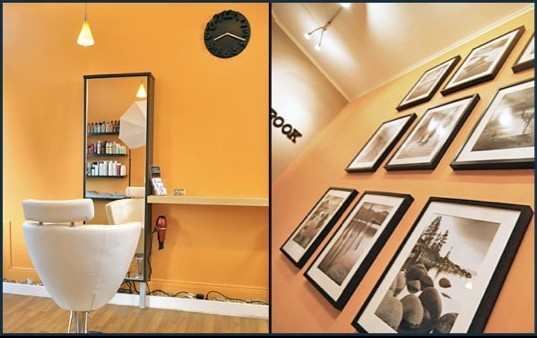
Referring with a hair professional is continuously a good, first step. They have the information, skills, and applied experience that can inform you of the best habits to straighten your hair and minimize the risks. You should start with a professional that you know for myself if possible or one that comes highly optional.
Once you choose on the hair specialist, you will maybe be scheduled for a "pre-treatment" meeting at the salon. This will permit the stylist to examine your hair to see if there are any difficulties or issues that might crop up just in case you want to go through with the hair straightening process. Be sure to notify them of any preceding treatments and how many you have had over the past few years as this can assist them make the best choice. Most hair specialists will save written records of what they have used earlier, so if you can gain access to those records, it will support.
Straightening or "relaxing" the hair is typically done through a chemical process that is really similar to one that curls the hair. Such chemicals essential to be balanced correctly depending on the hair type.
At this period, the professional may achieve a "strand test" which will control the kind of hair you have, the feel, and whether there is any harm from preceding treatments. Founded on this strand test, the specialist will know what types and strengths of chemicals will be used. Thin or fine hair will essential fewer chemicals, while medium-textured hair, which is the most collective, a regular-strength chemical procedure is used. Thick or coarse hair may need smooth more chemicals to achieve straightening.
Once your hair "passes the test" so to speak, you will then be scheduled for a hair straightening session.
Perhaps the most current method of straightening hair is normally known as "Thermal Reconditioning". This was a procedure first developed and made general in San Francisco. It usages a combination of chemicals and heat to relax the hair. If the procedure is positive, the hair will be straight for months and only need a few touch ups when wanted. However, the straightening procedure itself can last for several hours, so you will essential to clear out a good part of your day for this kind of treatment.
You may be a prime candidate for Thermal Reconditioning if you have not had many chemical treatments performed on your hair before, you hair professional will know and make their recommendations.
Additional popular relaxing process comes from Brazil and is normally known as the "Brazilian Keratin Treatment". In the use of chemicals and heat practical through hair straightening irons, it is usually similar to Thermal Reconditioning. This is a general method because it takes less initial time in the salon to do the procedure. Though more salon appointments are wanted afterwards to follow-up and save the hair straight. There has been some controversy with the Keratin Treatment in terms of the chemicals usages, so be sure to consult with your hair professional first to get if this is the best method to straighten our hair.
If you take the time to access with professionals first, it will assistance you make the best decision what procedures you should use to straighten your hair.
#keratin treatment near me#brazilian keratin straightening#brazilian keratin treatment san francisco#brazilian keratin san rafael#balayage san francisco#brazilian keratin#keratin smoothing treatment san francisco#brazilian keratin treatment#hair colorist san francisco#formaldehyde free keratin salon#best keratin treatment san francisco#keratin treatment and brazilian blowout specialist
0 notes
Video
vimeo
A bittersweet comedy about Steven, a recently divorced father and his young daughter, Cali. Steve’s perfect day with his daughter in San Francisco's Golden Gate Park is ruined when Cali’s mom comes to pick her up, leading Steve on an unexpected journey through the park. A Little Moving Pictures Production Of a film by 26 Aries (Irene Chin & Kurt Vincent) Written by: Adam Callahan Story By: Adam Callahan, Irene Chin, Kurt Vincent Produced by: Jeremy Summer Consulting Producer/Story Editor: Tricia Cramer Cast (in order of appearance): Steve: Steve Talley Cali: California Summer Dog: Beatrix Summerkirk Park Kid #1: Evan Walker Park Kid #2: William Walker Gabby: Alyssa Kompelien Park: Mom Melissa Chin Burger King Guy: Adam Callahan Stoner Chick: Irene Chin Stoner Dude: Alex Rapine And all the freaky people at 4/20/18 at Golden Gate Park Crew Irene Chin: Director Kurt Vincent: Director Jeremy Summer: Producer Tyler McPherron: Director of Photography Alex Rapine: 1st AD Jonathan Salazar: 1st AC Martin Bustamante: 2nd AC Ashley Valenzuela: 2nd AC Lemia Bodden: Coordinator Arthur Aravena: Gaffer Gaerick Duffin: Swing Ally Grace Esparza: Art Director Sam Hoiland: Art Assist Anya Zebroski: Wardrobe Stylist Alicia Barry: Hair & Makeup Artist Dalton Patterson: Sound Recordist Diana Rothery: Production Stills Additional Cinematography by Noe Chavez Music by Anthony Ferraro Editor: Nathan Petty Assistant Editor: Caleb Stumpfl Colorist: Chris Martin of Mission Film & Design Sound Mixer: Joel Raabe Titles Designer: Patrick Sean Gibson “Running In and Out” Performed By Dwayne Ellis Licensed from Marmoset Music “Children of the Beehive” written by Sonny Smith Performed by Sonny & The Sunsets Licensed from Bankrobber music Special Thanks Mission Film & Design Tommy Herbst Andrew Combra Dean Snodgrass Elise Polglaze Lindsey Kirk Mike Walker Melissa Chin Alan Steinheimer Morgan Henderson Ron E. Sweat Dedicated to: The park rangers who busted us but let us keep filming.
0 notes
Text
For A Black Social Media Manager In The George Floyd Age, Each Click Holds Trauma
Recently, as I scrolled the more than 1 million tweets connected to the hashtag #Black_Lives_Matter, this is what flashed before my eyes: the black-and-white dashcam video of Philando Castile’s girlfriend, Diamond Reynolds, in handcuffs crying, her 4-year-old daughter trying to comfort her; protesters in Berlin standing in solidarity with the BLM movement; a Now This video of a young Black girl calling herself ugly; police attacking protesters and protesters fighting back; an image of George Floyd unable to breathe.
Suddenly neither could I. My chest tightened, my heart beat faster and hot tears began to bubble from my eyes.
For a person of color, engaging in this moment of collective trauma — whether by watching and sharing the video of George Floyd’s death, discussing racial injustice on social media or speaking out in the 3D world — involves anxiously teetering across the fine lines between personal experience, obligations to the community, and — in my case — professional responsibilities. Since I manage a news organization’s social media platforms, it’s part of my job.
Many Americans describe watching the videos as a wake-up call to persistent racial injustice. For Black Americans, it touches a deeper nerve.
“I watched it. I tried not to cry. I was just in awe,” said Jason Cordova, 31, a comedian in Weymouth, Massachusetts. “I have a son. He’s 11. You gotta really prepare a Black kid to be treated less than human.”
Email Sign-Up
Subscribe to KHN’s free Morning Briefing.
Sign Up
Please confirm your email address below:
Sign Up
Ann Ebhojiaye, a psychotherapist in Baltimore, said the reaction is normal, reflecting “vicarious trauma” or “retraumatization from the Black experience in America.” You’re “seeing images and videos of violence against people that look like you and sometimes not being aware of what you’re experiencing,” she told me. Research suggests that repeated viewing of terrorism news coverage can lead to symptoms of post-traumatic stress disorder, especially in people who have previous exposure to violence. Yet the onslaught of distressing images is hard to escape.
These videos carry echoes of historical images showing slaves being punished and Ku Klux Klan lynchings, often made to publicize and celebrate these heinous acts, said Deirdre Cooper Owens, a professor and the director of the Humanities in Medicine Program at the University of Nebraska. “There is a long memory and expectation extending from slavery that Black suffering be public,” she said.
But Cooper Owens does not call for censorship of images. Instead, she points to the gratuitous nature of their sharing as a problem. Why, she asked, should Black people be subject to “the overrepresentation of our trauma?”
Yet there’s little doubt that these kinds of videos helped to grow the Black Lives Matter movement into an urgent national protest. Their viral nature forced society and even the global community to witness the brutality so many wanted to deny.
Some people of color are careful to consume in small doses to protect their equilibrium: “Anytime I decide to watch any of these videos, I always think before I do it. Once you see it, you can’t unsee it,” said Michelle Stafford (@divayogi), 42, a yogi and healer in Baltimore. After watching the video of Floyd, she said, “I took a shower. I was feeling so anxious, my heart rate was up. If I’m feeling this way in my house, in a safe space, I can only imagine what people in other circumstances are feeling.”
She is trying to help others in her community process their feelings by leading regular yoga sessions via Zoom, followed by group discussions, that are payment-optional. Kyaira Carter, 26 (@yokyni), offers similar sessions in Houston. “I want to use my platform to remind the Black community that healing is possible for us,” she said.
But Shannon Johnson, 37, of Los Angeles said watching these videos and discussing Floyd’s death on social media — however painful — helped her process what she saw and might force others to face buried truths. “I think if we can talk about everything else, we can talk about the uncomfortable stuff.”
As a script consultant and fan of horror films, she said she is somewhat “desensitized” to violence, so going through the hashtags reminds her of the reality of being Black in America. “When people say George Floyd’s name,” she said, “I see the video.”
She and many others credit the videos for helping to grow the Black Lives Matter movement into an urgent national conversation.
As a social media manager, I wonder if those of us in this field should be doing more to help users navigate this traumatic moment.
If you type the word “suicide” into your Twitter search bar, you are immediately presented with an embedded message that reads “Help is available,” as well as a phone number and link to the National Suicide Prevention Lifeline website.
If sensitive content such as the video of Floyd’s death and countless others like it is allowed on social media platforms, why shouldn’t that content be flagged with additional support and resources?
“There is a general lack of understanding from the social media industry about the effects of repeatedly consuming disturbing content,” said C. Vaile Wright, senior director of health care innovation at the American Psychological Association.
For instance, images that depict gratuitous gore and certain sexual content are not allowed on Twitter, but sensitive content such as the video of Floyd’s death does not break Twitter’s rules. It is allowed to appear on the platform, but it should appear with an interstitial — a filter that warns of sensitive content and blurs the content until you click and agree to see it, said Lauren Alexander, a senior manager on the product communications team at the Twitter HQ in San Francisco.
Video hashing tools are used across the social media industry to prevent re-uploads of violent videos, but they can’t stop re-uploads of versions that have been altered or edited. Likewise, the interstitial warnings may disappear when sensitive videos are edited and re-uploaded, as is the case with viral content, such as the killing of George Floyd.
One option is for users to adjust their safety settings on Twitter to block sensitive content and disable the autoplay function of videos on their timelines. “What we are trying to do and how we approach sensitive media is to not be the decision-maker, Alexander said. “We are not mental health providers.” She pointed out that she has more choice in what to watch on social media than if she kept CNN on in the background, where the video of the killing played repeatedly.
What’s clear is that simply unplugging isn’t adequate advice for communities of color trying to cope with the effects of vicarious trauma. Sometimes, as Ebhojiaye said, “it’s important to really process, why are you so emotional?” When you have that awareness, you can work toward taking action in a way that you feel is empowering, she said.
For me, watching Floyd’s agonizing death caused me to confront the pain of a lifetime of digesting racist and colorist messaging that seemed to scream, “Your skin is too dark, your hair is too kinky, your voice does not matter, your life does not matter!”
Viewing that video and other images that assault people who look like me is part of my profession. It can be very hard to steel yourself against the pain you see.
Part of my healing has involved reminding myself that I am both beautiful and worthy. That’s something I do through the art of storytelling, songwriting, performance art — and writing like this.
For A Black Social Media Manager In The George Floyd Age, Each Click Holds Trauma published first on https://smartdrinkingweb.weebly.com/
0 notes
Text
For A Black Social Media Manager In The George Floyd Age, Each Click Holds Trauma
Recently, as I scrolled the more than 1 million tweets connected to the hashtag #Black_Lives_Matter, this is what flashed before my eyes: the black-and-white dashcam video of Philando Castile’s girlfriend, Diamond Reynolds, in handcuffs crying, her 4-year-old daughter trying to comfort her; protesters in Berlin standing in solidarity with the BLM movement; a Now This video of a young Black girl calling herself ugly; police attacking protesters and protesters fighting back; an image of George Floyd unable to breathe.
Suddenly neither could I. My chest tightened, my heart beat faster and hot tears began to bubble from my eyes.
For a person of color, engaging in this moment of collective trauma — whether by watching and sharing the video of George Floyd’s death, discussing racial injustice on social media or speaking out in the 3D world — involves anxiously teetering across the fine lines between personal experience, obligations to the community, and — in my case — professional responsibilities. Since I manage a news organization’s social media platforms, it’s part of my job.
Many Americans describe watching the videos as a wake-up call to persistent racial injustice. For Black Americans, it touches a deeper nerve.
“I watched it. I tried not to cry. I was just in awe,” said Jason Cordova, 31, a comedian in Weymouth, Massachusetts. “I have a son. He’s 11. You gotta really prepare a Black kid to be treated less than human.”
Email Sign-Up
Subscribe to KHN’s free Morning Briefing.
Sign Up
Please confirm your email address below:
Sign Up
Ann Ebhojiaye, a psychotherapist in Baltimore, said the reaction is normal, reflecting “vicarious trauma” or “retraumatization from the Black experience in America.” You’re “seeing images and videos of violence against people that look like you and sometimes not being aware of what you’re experiencing,” she told me. Research suggests that repeated viewing of terrorism news coverage can lead to symptoms of post-traumatic stress disorder, especially in people who have previous exposure to violence. Yet the onslaught of distressing images is hard to escape.
These videos carry echoes of historical images showing slaves being punished and Ku Klux Klan lynchings, often made to publicize and celebrate these heinous acts, said Deirdre Cooper Owens, a professor and the director of the Humanities in Medicine Program at the University of Nebraska. “There is a long memory and expectation extending from slavery that Black suffering be public,” she said.
But Cooper Owens does not call for censorship of images. Instead, she points to the gratuitous nature of their sharing as a problem. Why, she asked, should Black people be subject to “the overrepresentation of our trauma?”
Yet there’s little doubt that these kinds of videos helped to grow the Black Lives Matter movement into an urgent national protest. Their viral nature forced society and even the global community to witness the brutality so many wanted to deny.
Some people of color are careful to consume in small doses to protect their equilibrium: “Anytime I decide to watch any of these videos, I always think before I do it. Once you see it, you can’t unsee it,” said Michelle Stafford (@divayogi), 42, a yogi and healer in Baltimore. After watching the video of Floyd, she said, “I took a shower. I was feeling so anxious, my heart rate was up. If I’m feeling this way in my house, in a safe space, I can only imagine what people in other circumstances are feeling.”
She is trying to help others in her community process their feelings by leading regular yoga sessions via Zoom, followed by group discussions, that are payment-optional. Kyaira Carter, 26 (@yokyni), offers similar sessions in Houston. “I want to use my platform to remind the Black community that healing is possible for us,” she said.
But Shannon Johnson, 37, of Los Angeles said watching these videos and discussing Floyd’s death on social media — however painful — helped her process what she saw and might force others to face buried truths. “I think if we can talk about everything else, we can talk about the uncomfortable stuff.”
As a script consultant and fan of horror films, she said she is somewhat “desensitized” to violence, so going through the hashtags reminds her of the reality of being Black in America. “When people say George Floyd’s name,” she said, “I see the video.”
She and many others credit the videos for helping to grow the Black Lives Matter movement into an urgent national conversation.
As a social media manager, I wonder if those of us in this field should be doing more to help users navigate this traumatic moment.
If you type the word “suicide” into your Twitter search bar, you are immediately presented with an embedded message that reads “Help is available,” as well as a phone number and link to the National Suicide Prevention Lifeline website.
If sensitive content such as the video of Floyd’s death and countless others like it is allowed on social media platforms, why shouldn’t that content be flagged with additional support and resources?
“There is a general lack of understanding from the social media industry about the effects of repeatedly consuming disturbing content,” said C. Vaile Wright, senior director of health care innovation at the American Psychological Association.
For instance, images that depict gratuitous gore and certain sexual content are not allowed on Twitter, but sensitive content such as the video of Floyd’s death does not break Twitter’s rules. It is allowed to appear on the platform, but it should appear with an interstitial — a filter that warns of sensitive content and blurs the content until you click and agree to see it, said Lauren Alexander, a senior manager on the product communications team at the Twitter HQ in San Francisco.
Video hashing tools are used across the social media industry to prevent re-uploads of violent videos, but they can’t stop re-uploads of versions that have been altered or edited. Likewise, the interstitial warnings may disappear when sensitive videos are edited and re-uploaded, as is the case with viral content, such as the killing of George Floyd.
One option is for users to adjust their safety settings on Twitter to block sensitive content and disable the autoplay function of videos on their timelines. “What we are trying to do and how we approach sensitive media is to not be the decision-maker, Alexander said. “We are not mental health providers.” She pointed out that she has more choice in what to watch on social media than if she kept CNN on in the background, where the video of the killing played repeatedly.
What’s clear is that simply unplugging isn’t adequate advice for communities of color trying to cope with the effects of vicarious trauma. Sometimes, as Ebhojiaye said, “it’s important to really process, why are you so emotional?” When you have that awareness, you can work toward taking action in a way that you feel is empowering, she said.
For me, watching Floyd’s agonizing death caused me to confront the pain of a lifetime of digesting racist and colorist messaging that seemed to scream, “Your skin is too dark, your hair is too kinky, your voice does not matter, your life does not matter!”
Viewing that video and other images that assault people who look like me is part of my profession. It can be very hard to steel yourself against the pain you see.
Part of my healing has involved reminding myself that I am both beautiful and worthy. That’s something I do through the art of storytelling, songwriting, performance art — and writing like this.
For A Black Social Media Manager In The George Floyd Age, Each Click Holds Trauma published first on https://nootropicspowdersupplier.tumblr.com/
0 notes
Text
For A Black Social Media Manager In The George Floyd Age, Each Click Holds Trauma
Recently, as I scrolled the more than 1 million tweets connected to the hashtag #Black_Lives_Matter, this is what flashed before my eyes: the black-and-white dashcam video of Philando Castile’s girlfriend, Diamond Reynolds, in handcuffs crying, her 4-year-old daughter trying to comfort her; protesters in Berlin standing in solidarity with the BLM movement; a Now This video of a young Black girl calling herself ugly; police attacking protesters and protesters fighting back; an image of George Floyd unable to breathe.
Suddenly neither could I. My chest tightened, my heart beat faster and hot tears began to bubble from my eyes.
For a person of color, engaging in this moment of collective trauma — whether by watching and sharing the video of George Floyd’s death, discussing racial injustice on social media or speaking out in the 3D world — involves anxiously teetering across the fine lines between personal experience, obligations to the community, and — in my case — professional responsibilities. Since I manage a news organization’s social media platforms, it’s part of my job.
Many Americans describe watching the videos as a wake-up call to persistent racial injustice. For Black Americans, it touches a deeper nerve.
“I watched it. I tried not to cry. I was just in awe,” said Jason Cordova, 31, a comedian in Weymouth, Massachusetts. “I have a son. He’s 11. You gotta really prepare a Black kid to be treated less than human.”
Email Sign-Up
Subscribe to KHN’s free Morning Briefing.
Sign Up
Please confirm your email address below:
Sign Up
Ann Ebhojiaye, a psychotherapist in Baltimore, said the reaction is normal, reflecting “vicarious trauma” or “retraumatization from the Black experience in America.” You’re “seeing images and videos of violence against people that look like you and sometimes not being aware of what you’re experiencing,” she told me. Research suggests that repeated viewing of terrorism news coverage can lead to symptoms of post-traumatic stress disorder, especially in people who have previous exposure to violence. Yet the onslaught of distressing images is hard to escape.
These videos carry echoes of historical images showing slaves being punished and Ku Klux Klan lynchings, often made to publicize and celebrate these heinous acts, said Deirdre Cooper Owens, a professor and the director of the Humanities in Medicine Program at the University of Nebraska. “There is a long memory and expectation extending from slavery that Black suffering be public,” she said.
But Cooper Owens does not call for censorship of images. Instead, she points to the gratuitous nature of their sharing as a problem. Why, she asked, should Black people be subject to “the overrepresentation of our trauma?”
Yet there’s little doubt that these kinds of videos helped to grow the Black Lives Matter movement into an urgent national protest. Their viral nature forced society and even the global community to witness the brutality so many wanted to deny.
Some people of color are careful to consume in small doses to protect their equilibrium: “Anytime I decide to watch any of these videos, I always think before I do it. Once you see it, you can’t unsee it,” said Michelle Stafford (@divayogi), 42, a yogi and healer in Baltimore. After watching the video of Floyd, she said, “I took a shower. I was feeling so anxious, my heart rate was up. If I’m feeling this way in my house, in a safe space, I can only imagine what people in other circumstances are feeling.”
She is trying to help others in her community process their feelings by leading regular yoga sessions via Zoom, followed by group discussions, that are payment-optional. Kyaira Carter, 26 (@yokyni), offers similar sessions in Houston. “I want to use my platform to remind the Black community that healing is possible for us,” she said.
But Shannon Johnson, 37, of Los Angeles said watching these videos and discussing Floyd’s death on social media — however painful — helped her process what she saw and might force others to face buried truths. “I think if we can talk about everything else, we can talk about the uncomfortable stuff.”
As a script consultant and fan of horror films, she said she is somewhat “desensitized” to violence, so going through the hashtags reminds her of the reality of being Black in America. “When people say George Floyd’s name,” she said, “I see the video.”
She and many others credit the videos for helping to grow the Black Lives Matter movement into an urgent national conversation.
As a social media manager, I wonder if those of us in this field should be doing more to help users navigate this traumatic moment.
If you type the word “suicide” into your Twitter search bar, you are immediately presented with an embedded message that reads “Help is available,” as well as a phone number and link to the National Suicide Prevention Lifeline website.
If sensitive content such as the video of Floyd’s death and countless others like it is allowed on social media platforms, why shouldn’t that content be flagged with additional support and resources?
“There is a general lack of understanding from the social media industry about the effects of repeatedly consuming disturbing content,” said C. Vaile Wright, senior director of health care innovation at the American Psychological Association.
For instance, images that depict gratuitous gore and certain sexual content are not allowed on Twitter, but sensitive content such as the video of Floyd’s death does not break Twitter’s rules. It is allowed to appear on the platform, but it should appear with an interstitial — a filter that warns of sensitive content and blurs the content until you click and agree to see it, said Lauren Alexander, a senior manager on the product communications team at the Twitter HQ in San Francisco.
Video hashing tools are used across the social media industry to prevent re-uploads of violent videos, but they can’t stop re-uploads of versions that have been altered or edited. Likewise, the interstitial warnings may disappear when sensitive videos are edited and re-uploaded, as is the case with viral content, such as the killing of George Floyd.
One option is for users to adjust their safety settings on Twitter to block sensitive content and disable the autoplay function of videos on their timelines. “What we are trying to do and how we approach sensitive media is to not be the decision-maker, Alexander said. “We are not mental health providers.” She pointed out that she has more choice in what to watch on social media than if she kept CNN on in the background, where the video of the killing played repeatedly.
What’s clear is that simply unplugging isn’t adequate advice for communities of color trying to cope with the effects of vicarious trauma. Sometimes, as Ebhojiaye said, “it’s important to really process, why are you so emotional?” When you have that awareness, you can work toward taking action in a way that you feel is empowering, she said.
For me, watching Floyd’s agonizing death caused me to confront the pain of a lifetime of digesting racist and colorist messaging that seemed to scream, “Your skin is too dark, your hair is too kinky, your voice does not matter, your life does not matter!”
Viewing that video and other images that assault people who look like me is part of my profession. It can be very hard to steel yourself against the pain you see.
Part of my healing has involved reminding myself that I am both beautiful and worthy. That’s something I do through the art of storytelling, songwriting, performance art — and writing like this.
from Updates By Dina https://khn.org/news/as-a-black-social-media-manager-in-the-george-floyd-age-each-click-holds-trauma/
0 notes